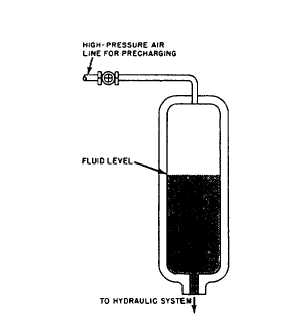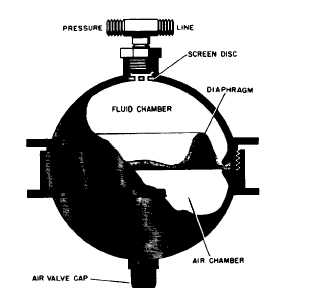port on the bottom and a pneumatic charging port
at the top (fig. 9-8). This type of accumulator is
used in some airplane elevator hydraulic systems
where several thousand gallons of fluid are needed
to supplement the output of the hydraulic pumps
for raising the elevator platform. The direct
contact between the air or gas and the hydraulic
fluid tends to entrain excessive amounts of gas
in the fluid. For this reason, direct contact
accumulators are generally not used for pressures
over 1200 psi. The use of this type of accumulator
with flammable fluid is dangerous because there
is a possibility of explosion if any oxygen is
present in the gas, and pressure surges generate
excessive heat. For this reason, safety fluids are
used in this type of installation.
DIAPHRAGM ACCUMULATORS
The diaphragm-type accumulator is con-
structed in two halves which are either screwed
or bolted together. A synthetic rubber diaphragm
is installed between both halves, making two
chambers. Two threaded openings exist in the
assembled component. The opening at the top,
as shown in figure 9-9, contains a screen disc
which prevents the diaphragm from extruding
through the threaded opening when system
pressure is depleted, thus rupturing the dia-
phragm. On some designs the screen is replaced
by a button-type protector fastened to the center
Figure 9-8.—Direct-contact gas-to-fluid accumulator.
Figure 9-9.—Diaphragm accumulator.
of the diaphragm. An air valve for pressurizing
the accumulator is located in the gas chamber end
of the sphere, and the liquid port to the hydraulic
system is located on the opposite end of the
sphere. This accumulator operates in a manner
similar to that of the bladder-type accumulator.
FILTRATION
You have learned that maintaining hydraulic
fluids within allowable limits is crucial to
the care and protection of hydraulic equipment.
While every effort must be made to prevent
contaminants from entering the system, con-
taminants which do find their way into the system
must be removed. Filtration devices are installed
at key points in fluid power systems to remove
the contaminants that enter the system along
with those that are generated during normal
operations.
Filtration devices for hydraulic systems differ
somewhat from those of pneumatic systems.
Therefore, they will be discussed separately.
The filtering devices used in hydraulic systems
are commonly referred to as strainers and filters.
Since they share a common function, the terms
strainer and filter are often used interchangeably.
As a general rule, devices used to remove large
particles of foreign matter from hydraulic fluids
are referred to as strainers, while those used to
remove the smallest particles are referred to as
filters.
9-7




